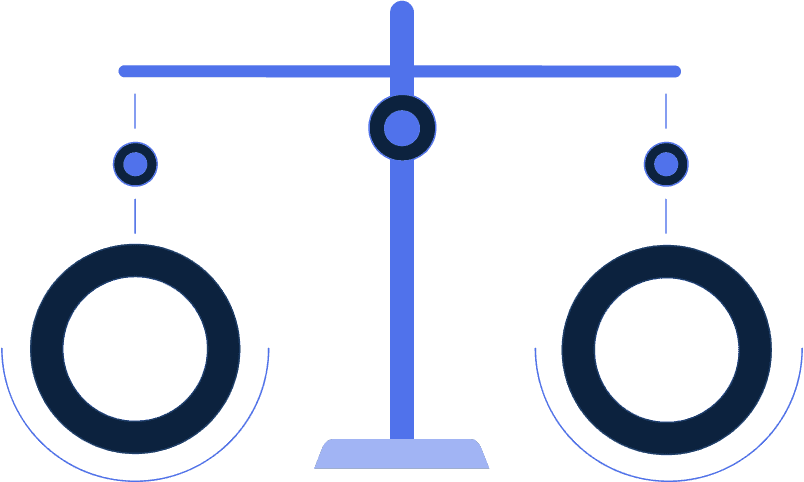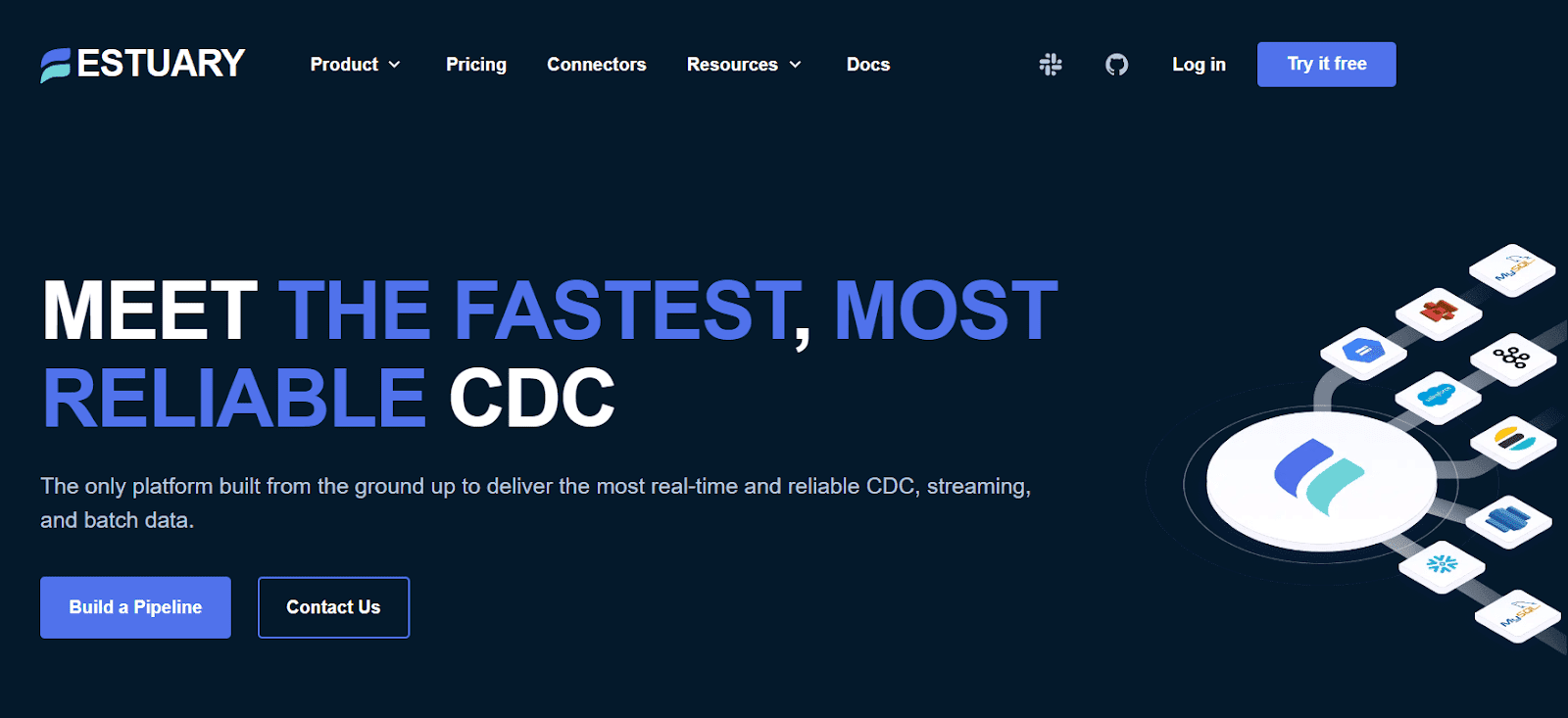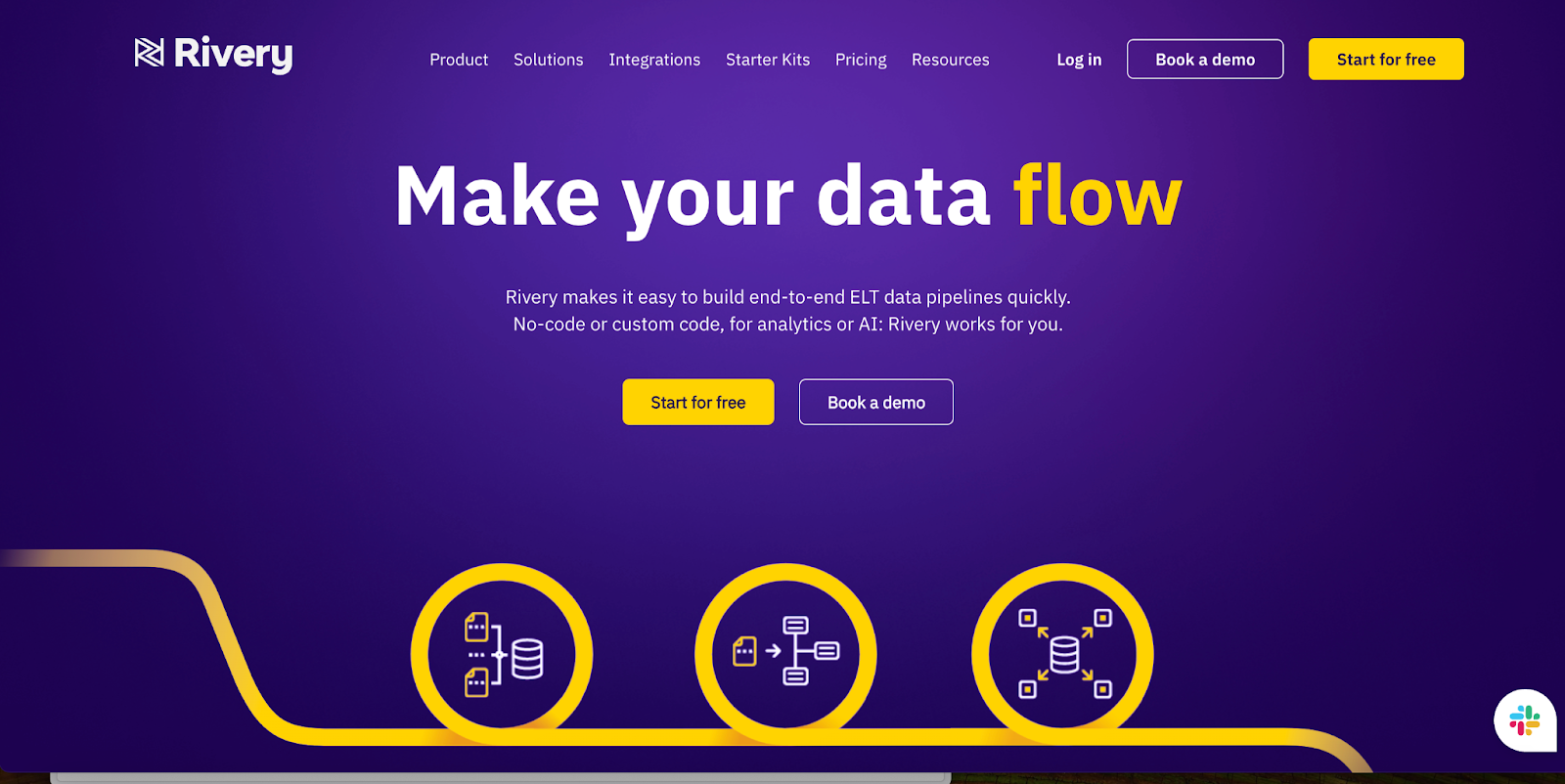Estuary Flow VS Rivery
Read this detailed 2024 comparison of Estuary Flow vs Rivery. Understand their key differences, core features, and pricing to choose the right platform for your data integration needs.
View all comparisons


Introduction
Do you need to load a cloud data warehouse? Synchronize data in real-time across apps or databases? Support real-time analytics? Use generative AI?
This guide is designed to help you compare Estuary Flow vs Rivery across nearly 40 criteria for these use cases and more, and choose the best option for you based on your current and future needs.
Comparison Matrix
 |  | ||
|---|---|---|---|
| Use cases | |||
| Database replication (CDC) - sources | Estuary FlowMySQL, SQL Server, Postgres, AlloyDB, MariaDB, MongoDB, Firestore, Salesforce, ETL and ELT, realtime and batch | RiveryMongoDB, MySQL, Oracle, Postgres, SQL Server | |
| Replication to ODS | Estuary Flow Requires re-extraction of sources for new destinations | Rivery | |
| Op. data integration | Estuary Flow | Rivery | |
| Data migration | Estuary Flow Great schema inference and evolution support. Support for most relational databases. Continuous replication reliability | Rivery | |
| Stream processing | Estuary Flow real-time ETL in Typescript and SQL | Rivery | |
| Operational Analytics | Estuary Flow Integration with real-time analytics tools. Real-time transformations in Typescript and SQL. Kafka compatibility. | Rivery | |
| AI Pipelines | Estuary Flow Pinecone (ETL) support. Transformations can call ChatGPT & other AI APIs. | Rivery | |
| Connectors | |||
| Number of connectors | Estuary Flow150+ high performance connectors built by Estuary | Rivery200+ | |
| Streaming connectors | Estuary FlowCDC, Kafka, Kinesis, Pub/Sub | RiveryCDC only | |
| Support for 3rd party connectors | Estuary Flow Support for 500+ Airbyte, Stitch, and Meltano connectors | Rivery | |
| Custom SDK | Estuary Flow SDK for source and destination connector development. | Rivery (REST) | |
| API (for admin) | Estuary Flow API and CLI support | Rivery (moving to new API) | |
| Core features | |||
| Batch and streaming | Estuary FlowBatch and streaming | RiveryBatch-only destinations | |
| Delivery guarantee | Estuary FlowExactly once (streaming, batch, mixed) | RiveryExactly once | |
| Load write method | Estuary FlowAppend only or update in place (soft or hard deletes) | RiverySoft and hard deletes, append and update in place | |
| DataOps support | Estuary Flow API and CLI support for operations. Declarative definitions for version control and CI/CD pipelines. | Rivery (CLI, API) | |
| ELT transforms | Estuary Flow dbt integration | Rivery (SQL, Python) | |
| ETL transforms | Estuary Flow Real-time, SQL and Typescript | Rivery Python (ETL or ELT). SQL runs in target (ELT). | |
| Schema inference and drift | Estuary Flow Real-time schema inference support for all connectors based on source data structures, not just sampling. | Rivery Limited to detection in database sources | |
| Store and replay | Estuary Flow Can backfill multiple targets and times without requiring new extract. User-supplied cheap, scalable object storage. | Rivery | |
| Time travel | Estuary Flow Can restrict the data materialization process to a specific date range. | Rivery | |
| Snapshots | Estuary Flow Full or incremental | Rivery N/A | |
| Ease of use | Estuary Flow streaming transforms may take learning | Rivery Requires some learning curve | |
| Deployment options | |||
| Deployment options | Estuary FlowOpen source, public cloud, private cloud | RiveryPublic cloud only (multi-tenant) | |
| The abilities | |||
| Performance (minimum latency) | Estuary Flow< 100 ms (in streaming mode) Supports any batch interval as well and can mix streaming and batch in 1 pipeline. | RiveryMinutes (60 minutes starter, 15 minutes professional, 5 minutes enterprise minimum) | |
| Reliability | Estuary FlowHigh | RiveryHigh | |
| Scalability | Estuary FlowHigh 5-10x scalability of others in production | RiveryMed-High | |
| Security | |||
| Data Source Authentication | Estuary FlowOAuth 2.0 / API Tokens SSH/SSL | RiveryOAuth / HTTPS / SSH / SSL / API Tokens | |
| Encryption | Estuary FlowEncryption at rest, in-motion | RiveryEncryption at rest, in-motion | |
| Support | |||
| Support | Estuary Flow Fast support, engagement, time to resolution, including fixes. Slack community. | Rivery | |
| Cost | |||
| Vendor costs | Estuary Flow 2-5x lower than the others, becomes even lower with higher data volumes. Also lowers cost of destinations by doing in place writes efficiently and supporting scheduling | Rivery Low for small volumes (< 20 GB a month) | |
| Data engineering costs | Estuary Flow Focus on DevEx, up-to-date docs, and easy-to-use platform. | Rivery Requires some learning for building pipelines and transforms. | |
| Admin costs | Estuary Flow “It just works” | Rivery | |

Estuary Flow

Estuary was founded in 2019. But the core technology, the Gazette open source project, has been evolving for a decade within the Ad Tech space, which is where many other real-time data technologies have started.
Estuary Flow is the only real-time and ETL data pipeline vendor in this comparison. There are some other ETL and real-time vendors in the honorable mention section, but those are not as viable a replacement for Fivetran.
While Estuary Flow is also a great option for batch sources and targets, where it really shines is any combination change data capture (CDC), real-time and batch ETL or ELT, and loading multiple destinations with the same pipeline. Estuary Flow currently is the only vendor to offer a private cloud deployment, which is the combination of a dedicated data plane deployed in a private customer account that is managed as SaaS by a shared control plane. It combines the security and dedicated compute of on prem with the simplicity of SaaS.
CDC works by reading record changes written to the write-ahead log (WAL) that records each record change exactly once as part of each database transaction. It is the easiest, lowest latency, and lowest-load for extracting all changes, including deletes, which otherwise are not captured by default from sources. Unfortunately ELT vendors like Airbyte, Fivetran, Meltano, and Hevo all rely on batch mode for CDC. This puts a load on a CDC source by requiring the write-ahead log to hold onto older data. This is not the intended use of CDC and can put a source in distress, or lead to failures.
Estuary Flow has a unique architecture where it streams and stores streaming or batch data as collections of data, which are transactionally guaranteed to deliver exactly once from each source to the target. With CDC it means any (record) change is immediately captured once for multiple targets or later use. Estuary Flow uses collections for transactional guarantees and for later backfilling, restreaming, transforms, or other compute. The result is the lowest load and latency for any source, and the ability to reuse the same data for multiple real-time or batch targets across analytics, apps, and AI, or for other workloads such as stream processing, or monitoring and alerting.
Estuary Flow also has broad packaged and custom connectivity, making it one of the top ETL tools. It has 150+ native connectors that are built for low latency and/or scale. While may seem low, these are connectors built for low latency and scale. In addition, Estuary is the only vendor to support Airbyte, Meltano, and Stitch connectors as well, which easily adds 500+ more connectors. Getting official support for the connector is a quick “request-and-test” with Estuary to make sure it supports the use case in production. Most of these connectors are not as scalable as Estuary-native, Fivetran, or some ETL connectors, so it’s important to confirm they will work for you. Flow’s support for TypeScript and SQL also enables ETL.
Pros
- Modern data pipeline: Estuary Flow has the best support for schema drift, evolution, and automation, as well as modern DataOps.
- Modern transforms: Flow is also both low-code and code-friendly with support for SQL, TypeScript (and Python coming) for ETL, and dbt for ELT.
- Lowest latency: Several ETL vendors support low latency. But of these Estuary can achieve the lowest, with sub-100ms latency. ELT vendors generally are batch only.
- High scale: Unlike most ELT vendors, leading ETL vendors do scale. Estuary is proven to scale with one production pipeline moving 7GB+/sec at sub-second latency.
- Most efficient: Estuary alone has the fastest and most efficient CDC connectors. It is also the only vendor to enable exactly-and-only-once capture, which puts the least load on a system, especially when you’re supporting multiple destinations including a data warehouse, high performance analytics database, and AI engine or vector database.
- Deployment options: Of the ETL and ELT vendors, Estuary is currently the only vendor to offer open source, private cloud, and public multi-tenant SaaS.
- Reliability: Estuary’s exactly-once transactional delivery and durable stream storage makes it very reliable.
- Ease of use: Estuary is one of the easiest to use tools. Most customers are able to get their first pipelines running in hours and generally improve productivity 4x over time.
- Lowest cost: for data at any volume, Estuary is the clear low-cost winner in this evaluation. Rivery is second.
- Great support: Customers consistently cite great support as one of the reasons for adopting Estuary.
Cons
- On premises connectors: Estuary has 150+ native connectors and supports 500+ Airbyte, Meltano, and Stitch open source connectors. But if you need on premises app or data warehouse connectivity make sure you have all the connectivity you need.
- Graphical ETL: Estuary has been more focused on SQL and dbt than graphical transformations. While it does infer data types and convert between sources and targets, there is currently no graphical transformation UI.
Pricing
Of the various ELT and ETL vendors, Estuary is the lowest total cost option. Estuary only charges $0.50 per GB of data moved from each source or to each target, and $100 per connector per month. So you can expect to pay a minimum of a few thousand per year. But it quickly becomes the lowest cost pricing. Rivery, the next lowest cost option, is the only other vendor that publishes pricing of 1 RPU per 100MB, which is $7.50 to $12.50 per GB depending on the plan you choose. Estuary becomes the lowest cost option by the time you reach the 10s of GB/month. By the time you reach 1TB a month Estuary is 10x lower cost than the rest.
Rivery

Rivery was founded in 2019. Since then it has grown to 100 people and 350+ customers. It’s a multi-tenant public cloud SaaS ELT platform. It has some ETL features, including inline Python transforms and reverse ETL. It supports workflows and can also load multiple destinations.
But Rivery is also similar to batch ELT. There are a few cases where Rivery is real-time at the source, such as with CDC, which is its own implementation. But even in that case it ends up being batch because it extracts to files and uses Kafka for file streaming to destinations which are then loaded in minimum intervals of 60, 15, and 5 minutes for the starter, professional, and enterprise plans.
If you’re looking for some ETL features and are OK with a public cloud-only option, Rivery is an option. It is less expensive than many ETL vendors, and also less expensive than Fivetran. But its pricing is medium-high for an ELT vendor.
Pros
- Modern data pipelines: Rivery is the one other modern data pipeline platform in this comparison along with Estuary.
- Transforms: You have an option of running Python (ETL) or SQL (ELT). You do need to make sure you use destination-specific SQL.
- Orchestration: Rivery lets you build workflows graphically.
- Reverse ETL: Rivery also supports reverse ETL.
- Load options: Rivery supports soft deletes (append only) and several update-in-place options including switch-merge (to merge updates from an existing table and switch), delete-merge (to delete older versions of rows), and a regular merge.
- Costs: Rivery is lower cost compared to other ETL vendors and Fivetran, though it is still higher than several ELT vendors.
Cons
- Batch only: While Rivery does extract from its CDC sources in real-time, which is the best approach, it does not support messaging sources or destinations, and only loads destinations in minimum intervals of 60 (Starter), 15 (Professional), or 5 (Enterprise) minutes.
- Data warehouse focus: While Rivery supports Postgres, Azure SQL, email, cloud storage, and a few other non data warehouse destinations, Rivery’s focus is data warehousing. It doesn’t support the other use cases as well.
- Public SaaS: Rivery is public cloud only. There is no private cloud or self-hosted option.
- Limited schema evolution: Rivery had good schema evolution support for its database sources. But the vast majority of its connectors are API-based, and those do not have good schema evolution support.
Pricing
Rivery charges per credit, which is $0.75 for Starter, $1.25 for Professional, and negotiated for Enterprise. You pay 1 credit per 100MB of moved data from databases, and 1 credit per API call. There is no charge for connectors. If you have low data volumes this will work well. But by the time you’re moving 20GB per month it starts to get more expensive than some others.
How to choose the best option
For the most part, if you are interested in a cloud option, and the connectivity options exist, you may choose to evaluate Estuary.
Modern data pipeline: Estuary has the broadest support for schema evolution and modern DataOps.
Lowest latency: If low latency matters, Estuary will be the best option, especially at scale.
Highest data engineering productivity: Estuary is among the easiest to use, on par with the best ELT vendors. But it also has delivered up to 5x greater productivity than the alternatives.
Connectivity: If you're more concerned about cloud services, Estuary or another modern ELT vendor may be your best option. If you need more on-premises connectivity, you might consider more traditional ETL vendors.
Lowest cost: Estuary is the clear low-cost winner for medium and larger deployments.
Streaming support: Estuary has a modern approach to CDC that is built for reliability and scale, and great Kafka support as well. It's real-time CDC is arguably the best of all the options here. Some ETL vendors like Informatica and Talend also have real-time CDC. ELT-only vendors only support batch CDC.
Ultimately the best approach for evaluating your options is to identify your future and current needs for connectivity, key data integration features, and performance, scalability, reliability, and security needs, and use this information to a good short-term and long-term solution for you.
GETTING STARTED WITH ESTUARY
Free account
Getting started with Estuary is simple. Sign up for a free account.
Sign upDocs
Make sure you read through the documentation, especially the get started section.
Learn moreCommunity
I highly recommend you also join the Slack community. It's the easiest way to get support while you're getting started.
Join Slack CommunityEstuary 101
I highly recommend you also join the Slack community. It's the easiest way to get support while you're getting started.
Watch



